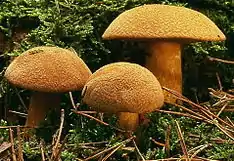Suillus variegatus
Suillus variegatus, commonly called the velvet bolete or variegated bolete, is a species of edible mushroom in the genus Suillus. Like all bolete-like species it has tubes, and pores, instead of gills under its cap. The mushroom forms a mycorrhizal relationship with pine and occurs in North America and Eurasia.
| Suillus variegatus | |
|---|---|
 | |
| Scientific classification | |
| Kingdom: | |
| Division: | |
| Class: | |
| Order: | |
| Family: | |
| Genus: | |
| Species: | S. variegatus |
| Binomial name | |
| Suillus variegatus | |
| Synonyms | |
|
Boletus variegatus Sw. (1810) | |
| Suillus variegatus | |
|---|---|
float | |
| pores on hymenium | |
| cap is convex | |
| stipe is bare | |
| spore print is brown | |
| ecology is mycorrhizal | |
| edibility: edible | |
Description
The cap is 6 – 13 cm in diameter. It is rusty to tawny, or ochraceous, and has a velvety or downy feel when young. As it matures the surface becomes smoother, even greasy, and tacky in wet periods. The stem is ochre, more yellow towards the top, and may be flushed with rust at the base. It is sometimes slightly bulbous. The flesh is pale lemon, and may turn very slightly blue on cutting. The pores are ochre, becoming more cinnamon later, and the spore print is walnut brown.[1] Said to smell like an ‘Earth ball’ fungus (Scleroderma).[2]
The variegatic acid is an orange pigment first isolated from Suillus variegatus.[3] It has strong antioxidant properties,[4][5] and a nonspecific inhibitory effect on cytochrome P450 enzymes.[6] When mushroom tissue containing variegatic acid is exposed to air, the chemical is enzymatically oxidized to blue quinone methide anions.[7]
Distribution and habitat
S. variegatus appears frequently with, and is mycorrhizal with two needle pine trees in late summer. It is often found with heathers, and other acid loving plants, on sandy soils. It is widespread in Europe, nearer parts of Asia,[2] and North America.
Edibility
Suillus variegatus is edible, but is said to smell unpleasant, with a somewhat metallic taste.[2] It is one of the most common wild mushrooms harvested for food in Finland.[8]
.jpg.webp)
References
- Roger Phillips (2006). Mushrooms. Pan MacMillan. ISBN 0-330-44237-6.
- Thomas Laessoe (1998). Mushrooms (flexi bound). Dorling Kindersley. ISBN 0-7513-1070-0.
- Edwards RL, Elsworthy GC (1967). "Variegatic acid, a new tetronic acid responsible for the blueing reaction in the fungus Suillus (Boletus) variegatus (Swartz ex Fr.)". Chemical Communications (London) (8): 373b–374. doi:10.1039/C1967000373B.
- Kasuga A, Aoyagi Y, Sugahara T (1995). "Antioxidant activity of fungus Suillus bovinus (L: Fr.) O. Kuntze". Journal of Food Science. 60 (5): 1113–85. doi:10.1111/j.1365-2621.1995.tb06304.x.
- Vidovic SS, Mujic IO, Zekovic ZP, Lepojevic ZD, Tumbas VT, Mujic AI (2010). "Antioxidant properties of selected Boletus mushrooms". Food Biophysics. 5 (1): 49–58. doi:10.1007/s11483-009-9143-6. S2CID 84061662.
- Huang YT, Onose J, Abe N, Yoshikawa K (2009). "In vitro inhibitory effects of pulvinic acid derivatives isolated from Chinese edible mushrooms, Boletus calopus and Suillus bovinus, on cytochrome P450 activity". Bioscience, Biotechnology, and Biochemistry. 73 (4): 855–60. doi:10.1271/bbb.80759. PMID 19352038. S2CID 39654350.

- Velíšek J, Cejpek K (2011). "Pigments of higher fungi: A review" (PDF). Czech Journal of Food Science. 29 (2): 87–102. doi:10.17221/524/2010-CJFS.
- Ohenoja, Esteri; Koistinen, Riitta (1984). "Fruit body production of larger fungi in Finland. 2: Edible fungi in northern Finland 1976—1978". Annales Botanici Fennici. 21 (4): 357–66. JSTOR 23726151.
| Wikimedia Commons has media related to Suillus variegatus. |